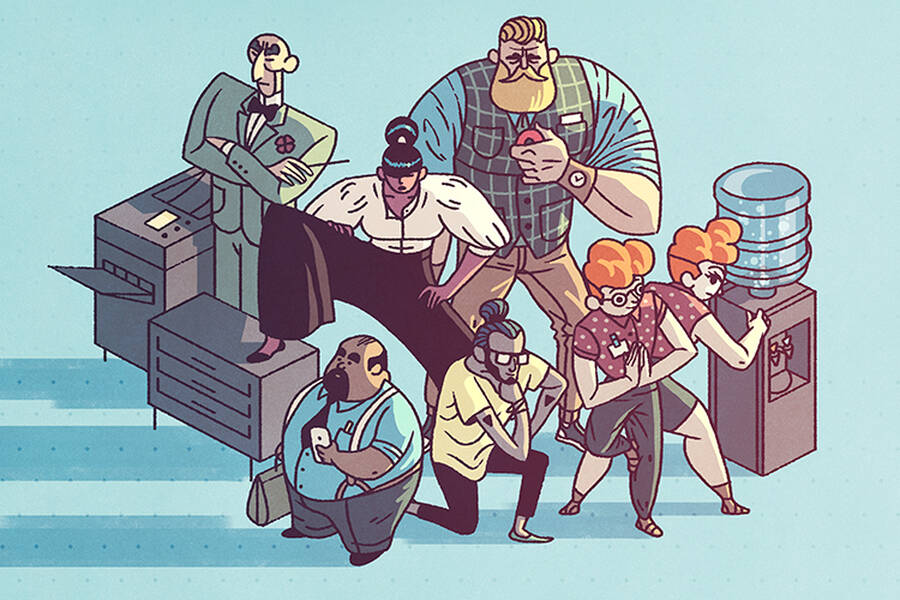There will always be a place for individual geniuses—for the lone wolves, the rogues, the nonconformists. But as the benefits of collaboration become clearer, individuals are sometimes at a disadvantage. In other words, these days, innovation is a team sport.
“There’s more and more to know in the world, and you can only have so much in your head,” explains Ben Jones, a Kellogg strategy professor. “So the share of stuff you know as an individual is declining in any field.”
This makes it critical to collaborate with others in order to push a project into new territory—whether that project is cutting-edge science or innovative customer service. But what does a collaborative workplace look like in practice? And how can leaders get there? Here’s what Kellogg faculty have to say.
1. Design a Collaborative Workplace
Want more collaboration? Encourage people to work together—as in, quite literally, the same physical spaces. Perhaps you’ve heard about how companies like Pixar have designed their headquarters to encourage chance encounters, such as making bathrooms centrally located.
“They were very intentional about wanting people who are artists and animators, and the coders, and the music people, and the screen writers to be constantly bumping into each other in random ways to spark ideas,” says Jones.
He explains that not every interaction is going to lead to a home run. But that’s okay. “It creates the greater probability of creating some interactions where you’re like, ‘Hey, wait a second, we should talk.’”
Don’t have millions to spend on a new office complex? Worry not. A regular bagel breakfast or afternoon happy hour can accomplish much the same thing.
2. Build the Right Teams
Of course, not all collaboration emerges from spontaneous conversations over bagels. Often managers deliberately assign specific team members to a certain project.
Should you find yourself in this position, here are a few important insights about teams to keep in mind:
For one, know that bigger and smaller teams each have their pros and cons. Bigger teams are great for projects that build upon earlier work. That’s because these projects tend to require a lot of expertise, manpower and political oomph to gain traction. But smaller, more agile teams are better equipped to come up with novel or experimental ideas. For instance, if you wanted to make a drastic change to your company’s operations, you might put a small team in charge of this change. “Then, if it actually works, you can spread it to the entire company,” says Dashun Wang, an associate professor of management and organizations.
Second, don’t make the all-too-common mistake of undervaluing your specialists. We have a natural tendency to compare people against one another—putting specialists, who excel in one area but might perform poorly in others, at a disadvantage. Think of it this way: Do you want five competent generalists on your team, or four competent generalists and one mediocre worker who absolutely excels in a niche area? On average, that fifth generalist might be the better employee. But as a team, you may be stronger with the specialist.
Finally, consider unusual pairings. Specifically, you may want to pair someone with a very unique or unusual background with someone else whose background is more conventionally aligned with a project. This can create that perfect blend of novelty and conventionality that Jones and Brian Uzzi, a professor of management and organizations, call a “virtuous mix.” Says Uzzi, “People who bring together expertise from different domains may be an essential feature of progress.”
Learn to hone and assess your collaboration skills in the upcoming Executive Education program Constructive Collaboration.
3. Set Some Ground Rules for Collaboration
So you’ve got your team in place. How will you structure your time together to get the most benefits?
“One of the biggest mistakes that leaders of new teams make is that they say something like, ‘our rule is that we have no rules,’” says Leigh Thompson, a professor of management and organizations. She explains that this approach tends to backfire. Rather than giving teams autonomy, it creates paralysis, as everyone waits for everyone else to take charge.
Thompson suggests creating a charter—a document that identifies, ideally in just a sentence, the team’s goals and who is responsible for what. “Teams that develop a charter end up being more nimble, having more proactive behavior, and achieving their goals more than teams that don’t bother,” she says.
4. Reward Consistent Contributors
Effective collaboration requires cooperation. And people who cooperate most effectively with each other have one thing in common: a consistent contributor.
“The consistent contributor looks for the collective good first and personal good second,” said the late Keith Murnighan, a longtime Kellogg professor of management and organizations. These are the people who tend to initiate cooperation, leading the way for others to follow suit.
Research by Murnighan finds that the actions of a consistent contributor can alter the dynamics of the entire group, making everyone more cooperative. The research also finds that consistent contributors seem to know when their contributions will have the most impact—and offer more when the stakes are highest.
When everyone is suspicious of everyone else, assuming they will hoard resources or put their own business unit first, it can become a self-fulfilling prophesy. But “in a larger group, if someone consistently acts as a friend, it’s easier for others to act as friends and everyone benefits,” as Murnighan put it.
So should you find yourself in a collaborative workplace that has no consistent contributor, consider playing that role yourself.
5. Know Which Tasks Could Benefit from Collaboration
Of course, it is important to keep in mind that sometimes there is a downside to collaboration, such as a loss in productivity.
This was the finding in research from operations professor Jan Van Mieghem and then–PhD student Lu Wang. Their study investigated collaboration among medical professionals—specifically, what happens when the doctors in charge of a patient (“hospitalists”) confer with specialists. They find that these consultations—regardless of how medically necessary—slow hospitalists’ productivity by about 20 percent.
“It’s not that any of these physicians are just sitting back and being on Facebook or reading the newspaper. They’re continuously busy,” says Van Mieghem. “But being busy may increase interruptions. At the end of the day, being busy may not equal being productive.”
It is important for managers to understand the potential costs of collaboration when deciding whether a given task should be distributed among many employees, or whether an individual really should keep it in her purview.




